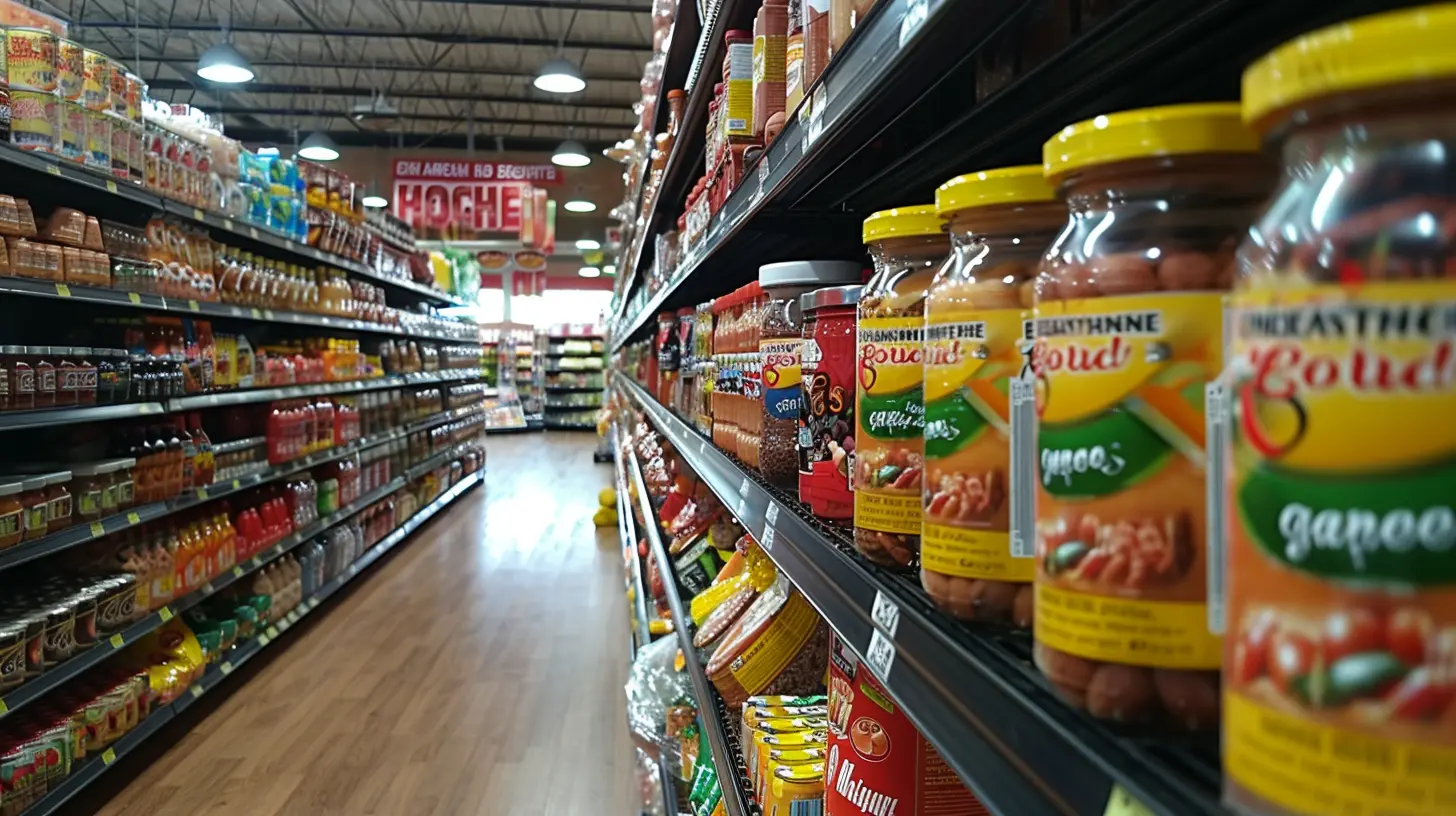Healthy Eating on a Budget: Tips for Family Grocery Shopping
19 December 2024
Whoever said eating healthy had to break the bank clearly hasn’t mastered the art of smart grocery shopping. Let’s be real—feeding a family while sticking to a budget and maintaining nutritional sanity can feel like juggling flaming swords. One wrong move, and you’re either overspending or stocking up on junk food. But don’t worry; with a little planning, a dash of creativity, and some savvy shopping strategies, you can stretch your dollar without sacrificing your family’s health.
So, grab your shopping list, and let's dive into some practical, budget-friendly tips to keep your family well-fed and happy!
Why Does It Feel So Hard to Eat Healthy on a Budget?
Before we get into the nitty-gritty, let’s address the elephant in the room: why does eating healthy feel so dang expensive? It's true—kale costs more than chips, organic chicken is pricier than frozen nuggets, and don’t even get me started on those trendy superfoods. But here’s the kicker: healthy eating doesn’t have to mean splurging on Instagram-worthy meals or loading your cart with overpriced "health" products. It's about making intentional, informed decisions and focusing on the basics.
1. Start With a Plan (Your Wallet Will Thank You)
You know that old saying—"Failing to plan is planning to fail"? It totally applies to grocery shopping. Wandering aimlessly through the aisles is a surefire way to overspend, especially with those sneaky endcap displays calling your name.Here’s how to get started:
- Create a Weekly Meal Plan: Write out your meals for the week before you set foot in the store. Base your plan around what you already have at home (more on that later), and think about recipes that use overlapping ingredients.
- Make a Detailed Shopping List: Once you’ve mapped out your meals, create a shopping list organized by store sections (produce, dairy, pantry, etc.). This will keep you focused and help you avoid impulse buys.
- Set a Budget and Stick to It: Decide on a realistic grocery budget for the week. Bring cash if you tend to overspend—it’s harder to throw that extra fancy cheese in the cart when you’re juggling physical bills.
2. Shop Your Pantry Before You Shop the Store
Imagine this: you’re halfway through unloading your groceries when you realize you just bought a second bag of rice—even though you’ve got two unopened ones sitting in the pantry. Sound familiar?Before heading to the store, take inventory of what’s already in your kitchen. Chances are, you’ve got some hidden gems (hello, canned beans and forgotten pasta) that can form the backbone of your weekly meals. Use these staples as the starting point for your meal planning. Not only does this cut down on waste, but it also saves you money—you’re essentially eating up your "pantry profit."
3. Buy in Bulk (Without Going Overboard)
Bulk buying is a blessing and a curse. Sure, those huge bags of oats or frozen veggies can save you a ton in the long run, but only if you’ll actually use them. Buying a 10-pound bag of almonds when your family barely eats nuts? Not so much.Here’s the trick: focus on non-perishable items your family already loves and eats regularly. Think rice, beans, pasta, oats, or even frozen fruits and vegetables. If you’ve got the storage space, these bulk items can stretch across meals for weeks without going bad. Just remember: bulk buying doesn't mean buying impulsively—stick to what you know you’ll use.
4. Don’t Be Afraid of Generic or Store Brands
Newsflash: the brand name on the box doesn’t make food taste better (or healthier). Store-brand products often contain the exact same ingredients as their pricier counterparts, just without the flashy packaging. Take peanut butter, for example—whether it’s a big-name brand or the store’s version, the ingredient list is usually identical.Switching to generics can save you a few bucks on each item, which really adds up over time. Use that saved cash to splurge on fresher produce or higher-quality cuts of meat.
5. Get Friendly With Your Freezer
What’s one of the best ways to save money and reduce waste? Your freezer. This powerhouse appliance can keep food fresher for longer and give you more leeway in meal planning.- Frozen Fruits and Veggies: These are often picked and preserved at their peak, making them just as nutritious (and usually cheaper) as fresh produce. They’re perfect for smoothies, soups, or stir-fries.
- Batch Cooking and Freezing: Got a busy week ahead? Cook in bulk (think casseroles, soups, or chili), portion it out, and freeze the extras. Future-you will be so grateful when all you have to do is reheat a homemade meal.
- Freeze That Discount Meat: Buying meat on sale? Freeze it! Just make sure you portion it out before tossing it in the freezer—it’ll save you from having to defrost more than you need.
6. Shop With the Seasons
Ever noticed how strawberries cost a small fortune in winter? That’s because they’re not in season. Buying produce that’s out of season means paying extra for it to be shipped from halfway across the world.Instead, focus on seasonal fruits and veggies—they’re not only cheaper but also tastier. Better yet, check out local farmers’ markets for even fresher (and often more affordable) options. Can’t finish a giant haul of zucchini? Freeze it or try your hand at fun recipes like zucchini muffins or fritters.
7. Meatless Meals Are Your Budget’s Best Friend
Let’s talk meat. It’s probably one of the most expensive items on your shopping list, right? While protein is essential for a healthy diet, you don’t have to get it exclusively from meat. Incorporating a few meatless meals into your week can save you a ton of cash without skimping on nutrition.Think about hearty, plant-based proteins like lentils, chickpeas, black beans, tofu, or eggs. Whip up a veggie stir-fry, a comforting lentil soup, or a creative bean chili. Your family might not even notice the lack of meat!
8. Embrace Simple, Wholesome Ingredients
Here’s a secret: you don’t have to cook fancy meals to eat healthy. Basic, whole ingredients—like grains, beans, fresh produce, and eggs—can come together in endless combinations for balanced, delicious meals.For example, rice and beans are a classic combo for good reason—they’re cheap, filling, and easy to jazz up with spices or a splash of salsa. A frittata made with eggs and leftover veggies? Chef’s kiss. Eating healthy doesn’t mean reinventing the wheel; sometimes, it’s about finding joy in simple, satisfying dishes.
9. Avoid the Sneaky Budget Busters
We’ve all been there: you hit the checkout line feeling proud of your grocery haul, only to get sticker shock when you see the total. Those sneaky budget busters can creep up fast.- Pre-Packaged Snacks: Sure, those single-serving packs are convenient, but they’re way more expensive than buying in bulk and portioning out your own snacks.
- Beverages: Sodas, juices, fancy coffee drinks—they’re fun, but they can seriously drain your budget. Stick to water (or homemade drinks) and save the extras for special occasions.
- Impulse Buys: Those bakery cookies or random seasonal treats? They add up. If it’s not on your list, skip it.
10. Get Creative With Leftovers
Ever feel like you’re just tossing money in the trash when you throw out leftovers? Same. Instead of letting last night’s dinner lurk in the fridge for days, turn it into something new.Got leftover roast chicken? Shred it into tacos or toss it into a soup. Extra rice? Stir-fry it with some veggies and an egg for a quick dinner. Leftover spaghetti? Bake it with some cheese on top for a fun twist. With a little creativity, leftovers can become a free pass to skip cooking (and spending) for a night.
11. Use Technology to Your Advantage
Who says tech is only good for TikTok dances? These days, there are tons of apps and tools designed to help you save on groceries.- Couponing Apps: Apps like Ibotta, Rakuten, or Honey can help you find discounts and rebates on items you already buy.
- Store Loyalty Programs: Many grocery stores have free loyalty programs that offer discounts, digital coupons, or even cash back.
- Online Price Comparisons: If you’re shopping online, compare prices across stores to make sure you’re getting the best deal.
Wrapping It Up
Eating healthy as a family doesn’t mean splurging on organic everything or stressing over your grocery bill. It’s about balance, creativity, and a little bit of strategy. By planning meals, shopping smart, and embracing simple, whole foods, you can fill your family’s plates (and bellies) without emptying your wallet. At the end of the day, it’s not about perfection—it’s about progress. Happy (and healthy) grocery shopping!all images in this post were generated using AI tools
Category:
Healthy MealsAuthor:

Kelly Snow
Discussion
rate this article
13 comments
Porter Allen
In aisles of color, where choices abound, Nourish your kin with wisdom profound. On a budget, we thrive, with love as our guide, Healthy meals bloom, as family bonds glide.
February 8, 2025 at 4:57 PM

Kelly Snow
Thank you for your beautiful words! They perfectly capture the essence of nourishing our families with love and wisdom while making budget-friendly choices.
Natalia Sanders
Embracing healthy eating on a budget is not just about saving money; it's a profound opportunity to teach our children the value of nourishment, creativity, and sustainability. By prioritizing whole foods, we cultivate mindful habits that extend beyond the grocery aisle and into their futures.
January 31, 2025 at 5:13 PM

Kelly Snow
Thank you for highlighting the broader benefits of healthy eating on a budget! It truly fosters essential values and lifelong habits for both children and families.
Soryn Sanchez
How do you find the best deals?
January 26, 2025 at 4:12 AM

Kelly Snow
I recommend planning meals ahead, using shopping lists, comparing prices, and taking advantage of sales and coupons to find the best deals.
Isabelle Clark
Plan meals ahead, buy in bulk, and focus on seasonal produce for budget-friendly nutrition.
January 15, 2025 at 3:43 AM

Kelly Snow
Absolutely! Planning meals and buying seasonal produce in bulk not only saves money but also ensures nutritious meals for the family. Great tip!
Ardyn McVaney
Great tips for families looking to eat healthy without breaking the bank! I appreciate the practical advice and budget-friendly strategies shared here. Thank you for helping us make healthier choices!
January 10, 2025 at 5:02 AM

Kelly Snow
Thank you for your kind words! I'm glad you found the tips helpful for healthy family meals on a budget!
Colin Scott
Healthy eating on a budget? Please! With a sprinkle of creativity and a dash of sass, anyone can turn grocery shopping into a gourmet adventure!
January 5, 2025 at 4:55 PM

Kelly Snow
Absolutely! With a little creativity and flair, budget-friendly meals can be both delicious and exciting. Happy cooking!
Isadora McGee
Balancing nutrition and budget is possible with mindful shopping. Prioritize whole foods, plan meals, and embrace seasonal produce to maximize both health and savings.
January 1, 2025 at 3:49 AM

Kelly Snow
Thank you for the insightful comment! Mindful shopping truly empowers families to eat healthily while staying within budget. Prioritizing whole foods and seasonal produce is key to maximizing both nutrition and savings.
Alexia Thornton
Thank you for sharing these valuable tips! It’s encouraging to see practical ways to maintain healthy eating while being budget-conscious. I look forward to implementing these strategies for my family’s grocery shopping.
December 24, 2024 at 5:15 AM

Kelly Snow
Thank you for your kind words! I'm glad you found the tips helpful and wish you success in implementing them for your family!
Yazmin Lewis
Great tips! Focusing on whole foods and planning meals can make healthy eating affordable and enjoyable for the whole family.
December 23, 2024 at 4:47 PM

Kelly Snow
Thank you! I'm glad you found the tips helpful. Whole foods and meal planning are key to creating budget-friendly and enjoyable meals for everyone!
Dusk Riley
Budget bites: healthy can be fun!
December 22, 2024 at 4:47 PM

Kelly Snow
Absolutely! Eating healthy on a budget can be both enjoyable and creative. With a little planning, you can make nutritious meals that delight the whole family without breaking the bank!
Jolene Chapman
Thank you for sharing these practical tips! As a parent, I often struggle with balancing nutrition and budget. Your insights will definitely help me make healthier choices for my family. Grateful for this guidance!
December 20, 2024 at 5:02 AM

Kelly Snow
I'm so glad to hear that you found the tips helpful! Balancing nutrition and budget can be challenging, but small changes can make a big difference. Thank you for your kind words!
Derek Tucker
Implementing healthy eating on a budget requires planning and creativity. Focus on seasonal produce, buy in bulk, and prioritize whole foods. Meal prepping can reduce waste and save money. Involve the whole family in selecting and preparing meals to encourage healthier choices and strengthen bonds.
December 19, 2024 at 5:32 PM

Kelly Snow
Absolutely! Planning and creativity are key to healthy eating on a budget. Emphasizing seasonal produce, bulk buying, and meal prepping not only saves money but also fosters family involvement in healthier choices. Great tips!
Uma Carey
Great tips! Eating healthy on a budget can feel daunting, but your advice makes it so much easier! I love the idea of involving the kids in meal planning—what a fun way to teach them about nutrition and savings. Can’t wait to try these strategies with my family!
December 19, 2024 at 4:15 AM

Kelly Snow
Thank you so much! I'm glad you found the tips helpful and that you're excited to involve your kids in meal planning. Happy cooking!
MORE POSTS

Family-Friendly Plant-Based Meal Planning

How Consistent Routines Can Improve Toddler Behavior

Creative Outdoor Activities That Get Kids Moving

Baby Blues vs. Postpartum Depression: Know the Difference

Safe Teething Products Every Parent Can Trust

Lessons From My Dad: What Fatherhood Taught Me

Handling Stress-Induced Illnesses in Children: What Every Parent Should Know

The Art of Saying No Without Closing the Conversation

Easy One-Pot Meals for Nutritious Family Dinners